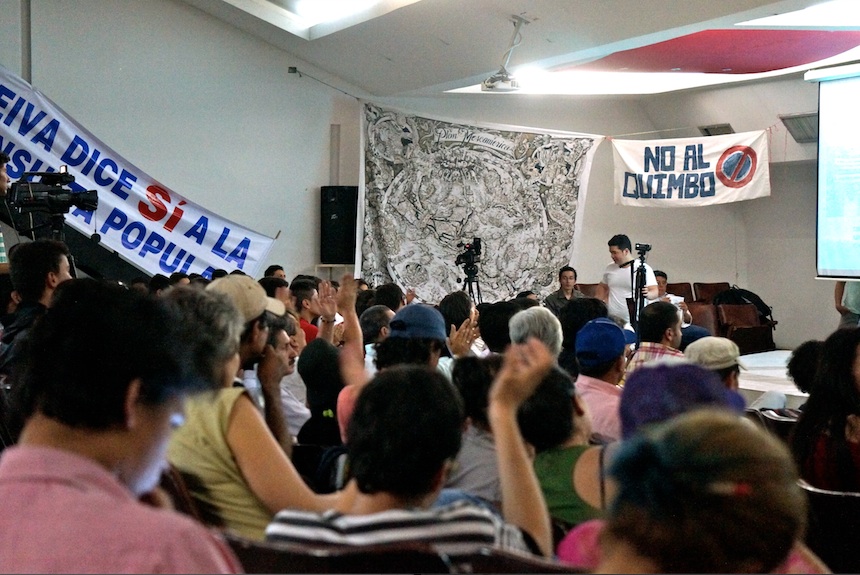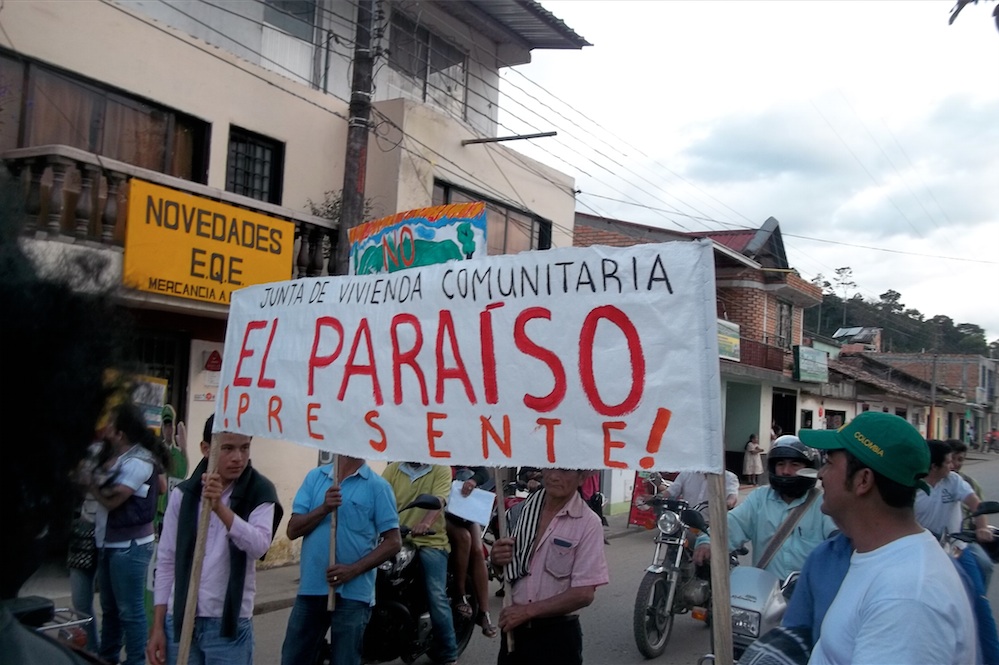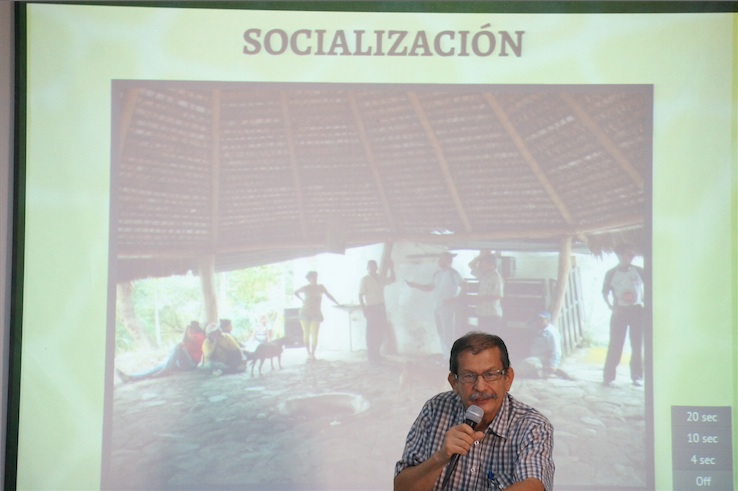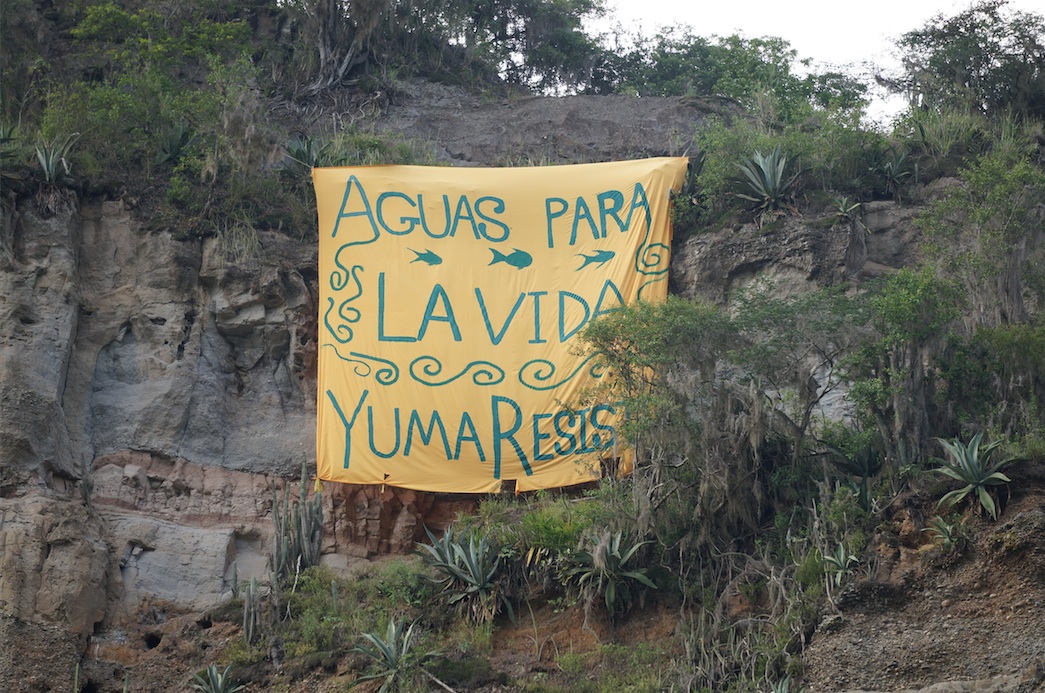All photographs by Alex Baumhardt.
THE MAGDALENA is Colombia’s biggest and most prized river — a crooked, rambling basin that cuts through the western half of the country for about 1,000 miles. The basin, which runs from the southwest corner near Ecuador through two subranges of the Andes mountains, is the aquatic lifeblood of the country: supplying water to 80 percent of the country’s population, it is also home to 2,735 species of animals, 20 percent of the world’s bird species, and soon up to 15 new hydroelectric dams. As Colombia emerges from 50 years of internal conflict, foreign development is rushing in, and a race to harness and manipulate the power of the Magdalena is on.
The size, breadth, and seaward flow of the river — an ideal ecosystem for wildlife and local populations of farmers and fisherman alike — also make it an ideal dumping ground for waste from industrial agriculture, commercial and illegal mining, and Colombia’s state-owned oil company, Ecopetrol. Ecopetrol’s largest refinery is located along the most polluted banks of the Magdalena in the town of Barrancabermeja, where 80 percent of Colombia’s oil is processed. Furthermore, Colombia sits on the largest coal deposits in South America, much of which are transported on the river to port cities on the Caribbean coast. In 2013, three ships owned by Alabama-based coal giant Drummond Company, carrying coal from the company’s inland Colombia mines, sank in the Magdalena. Not until January 2014 were they fined, a mere 3.5 million USD. Drummond’s Colombian mines themselves were worth around 3 billion USD at that time.
Near the headwaters in Huila, an area southwest of Colombia that’s slightly smaller than New Jersey, the river has been relatively untouched. Paramilitary groups used the territory as a stronghold for most of the conflict years; development companies, especially foreign ones, stayed out. Today, it is still primarily home to communities of fisherman, farmers, and coffee growers who may soon need to contend with up to six of the 15 new hydroelectric dams. Notably, 90 percent of Colombia’s coffee production comes from the Magdalena River basin, in areas like Huila.
In the town of San Agustín, Huila, many first learned of this when they spotted drones flying over the river in 2011. Lina Osorio of San Agustín, who co-runs a foundation for sustainable agriculture, investigated the sightings after neighbors who farm along the river’s banks reported seeing the drones overhead. She learned they were collecting information on potential dam sites for a plan that was set in motion two years prior.

The Master Plan
In 2009, the Colombian government entered into a partnership with the Chinese government to develop a “Master Plan” for the Magdalena River’s future. Chinese banks and companies are the largest financiers of dam-building in the world, and China is the second-largest trading partner with Colombia, after the United States. For Colombia, the Regional Autonomous Corporation of the Magdalena River (Cormagdalena) was assigned the project; for the Chinese, Hydrochina Corporation. The cost of creating the Master Plan came in at 6,428,750 USD. Cormagdalena contributed $710,750, with Hydrochina picking up $1.859 million and the Chinese government the remaining $3.859 million. Somewhat implicit in the agreement was that Hydrochina would have the upper hand when individual contracts from the Plan were awarded. But in August 2014, the first contract, for navigation of 564 miles of the Magdalena River to the Caribbean coast, was given to Brazilian dam giant Odebrecht instead. Hydrochina has since closed its office in Bogotá and directed all queries about the project to Cormagdalena.
César Garay, an advisor at Cormagdalena, said, “For 60 years, nobody paid attention [to the Magdalena] except the local communities who depended on the river. But the political community never paid attention to it.”
The Plan calls for increased navigation, ports, land reclamation, the use and preservation of natural and fish resources, and promotion of energy generation by building 11 to 15 hydroelectric dams on a river that currently has only one.
The Plan wasn’t finished until early 2014 and is not yet considered a public document, as it is only available in English and Chinese (according to a law enacted in March 2014, it doesn’t have to be made public until it is in Spanish). Timelines designating a Spanish-language version by September 2014 have been pushed back to an indefinite date. However, it is possible to request an English version from Cormagdalena and, after a dam-resistance leader in San Agustín received his requested copy, I pored over the 400-page document.
Huila is already home to the only other dam on the Magdalena, called Betania, and one other that’s been under construction since 2011, separate from the Master Plan, called El Quimbo. Construction on the Betania dam began in 1987, prior to requirements for comprehensive social and environmental impact assessments, and was built in a high-threat volcanic zone. Cormagdalena, an entity written into Colombia’s Constitution to manage the development of the river, wasn’t created until 1991, four years after Betania was built.
“When Cormagdalena was created there was no knowledge base to manage this river,” Garay said.
 Above: Meeting against the dam.
Above: Meeting against the dam.
Below: Protest.

Colombia, a Domestically Self-Sufficient Energy Exporter
The fisherman and farmers in Huila argue that the new dam construction is unnecessary. Colombia currently produces enough energy already to meet domestic demand, 70 percent of which is hydroelectric from other major rivers, and exports its surplus to Venezuela, Panama, and Ecuador. The Master Plan states that by 2018, after the first four of the potential dams are built, “no newly constructed hydropower station will be needed in Colombia.” Nevertheless, up to 11 more could be built on the river.
Proponents of dam-building argue that Colombia would burn less coal because of the increase in hydroelectricity, which is largely considered cleaner and more sustainable. Energy generation by the first four hydroelectric dams outlined in the Plan could be enough to reduce consumption of fossil fuels in Colombia by the equivalent of about 980,000 tons of coal per year. But Huila’s river communities say this comes at too great a cost: the loss of their lands and livelihoods.
The El Quimbo dam is slated to be completed and generating electricity by the beginning of 2015, only seven miles from Betania. The dam site was originally rejected in 1997 because of social and environmental impacts, including encroachment on an Amazonian forest reserve. But in 2009 Emgesa, the Colombian subsidiary of Spanish electricity company Engesa, was granted the environmental license for reasons of public utility and social interest.
“Betania was bad but Quimbo is a disaster,” Garay said.
Since the environmental license was awarded for El Quimbo, resistance groups have sprung up across Huila to fight it and to speak out against other major development projects along the river. The most vocal group among them has been Asoquimbo, the Association of Affected Peoples of the El Quimbo Dam Project, led by University of Southern Colombia Professor Miller Dussán.
“The resistance began for fair compensation for affected peoples and grew into a resistance of all dams on the river,” Dussán said.

Miller Dussán presenting information at dam resistance meeting.
Who Will Be Compensated for the Dam’s Negative Effects?
Emgesa first provoked the dam’s opponents with a survey it conducted prior to construction of El Quimbo, which included 1,537 people who would be directly affected and need compensation due to the project. The census did not measure those indirectly affected, like fisherman who don’t own land or farmers who rent their land. In light of this, a group of seven fisherman and farmers from the area brought a cumulative case to Colombia’s Constitutional Court.
In its decision, the court officially defined dam-affected peoples as those who will suffer the loss of food and housing security, human dignity, or other fundamental rights. Emgesa was ordered to conduct a new census within six months of the hearing and, in September of last year, the company announced a list of 28,744 people to be considered for compensation. Unfortunately, the court ordered a timeline for delivery of the new census but not a timeline for compensation of those included in the census. In a September 2014 article in the Colombian newspaper La Nacion, the General Manager of Endesa, Lucio Rubio Díaz, said the company is now analyzing each of the 28,744 cases in the census individually.
“Studying individually 28,000 people could take the rest of this century,” Dussán said.
Many fear this is a sign of what’s to come with the Master Plan dam projects. Tobias Ortiz, a fisherman in Huila, has already experienced the impact of both the Magdalena’s dams. “The first time, with Betania, I never received any compensation. Now, we will have El Quimbo, and I’m not receiving anything,” he said. According to the Master Plan, there are 46,000 fishermen who count on the river for their livelihood; 60 percent of all fish produced in Colombia come from the Magdalena River basin.
Juan Silva, a farmer from the town of Altamira, Huila, worked for 15 years along the Magdalena River before the landowner from whom he rented sold to Emgesa. In Colombia, 61 percent of agricultural land belongs to .04 percent of the country’s farmers, and there is no limit to the amount of land a foreign person or company can purchase. Today, Silva uses his motorcycle as a taxi in Garzón, a bigger city several miles down river, to make a living.
But Garay hopes that by creating the Master Plan, Cormagdalena will avoid another El Quimbo.
“We don’t want something like Quimbo to happen again,” he said.

Banner above the Magdalena in La Jagua.
In 2012, Hydrochina and Cormagdalena asked the Colombian office of US-based non-profit The Nature Conservancy (TNC) to work as a technical advisor on the project. TNC has worked quietly in Colombia for the past 30 years and has been developing its own master plan of sorts for the river. They’ve included the Magdalena in their Great Rivers Partnership, aimed at promoting sustainable development in eight important river basins around the world.
But TNC declined the offer to work as an active partner and instead gave Cormagdalena and Hydrochina the information it had collected until that point. TNC’s vision for the river includes promoting fish production and reforestation with native species to slow erosion among others. The plan makes concessions for dams, with the understanding that those companies that build them can also afford basic improvements in the area around the dam site. Unfortunately, the TNC’s plan lacks studies on the social implications of building dams along the river.
“We want to work towards that, but we also assume that if you can improve natural ecosystems, you are improving livelihoods along the river,” said Juliana Delgado, a fresh water specialist at TNC.
But Dussán finds little ground in this assumption, or in government or corporate responsibility to follow through on compensating affected river communities. On October 27, 2014, he visited Washington, DC to present what Asoquimbo sees as the social implications of the dams to the Inter-American Commission on Human Rights. His visit was part of a discussion on forced displacement and development projects that continue to rise as Colombia rebuilds.
“Many in Colombia believe the only form of displacement is from armed conflict, and they ignore the displacement that comes from development,” he said.
At a recent meeting of Asoquimbo and regional resistance groups, several miles away from where the reservoir at El Quimbo was filling with water, the auditorium filled with chants from dam opponents. Dussán pointed directly to a camera in the crowd and said,
“This is about energy for whom, by whom, and at what cost to us.”
¤
Alex Baumhardt is a freelance journalist, formerly of The Reykjavík Grapevine.
LARB Contributor
Alex Baumhardt is a freelance journalist, formerly of The Reykjavík Grapevine.
LARB Staff Recommendations
European (Union) Nihilism
Syriza’s election in Greece signals a response to the European Union’s latent nihilism — one that Nietzsche and Heidegger both foresaw.
Puppet Shows in a Swimming Pool: Surrealism, Punk, Poetry, and Contemporary Folklore According to Iceland’s Sjón
New from "Around the World"
Did you know LARB is a reader-supported nonprofit?
LARB publishes daily without a paywall as part of our mission to make rigorous, incisive, and engaging writing on every aspect of literature, culture, and the arts freely accessible to the public. Help us continue this work with your tax-deductible donation today!
